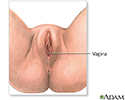Vulvar cancer
Cancer - vulva; Cancer - perineum; Cancer - vulvar; Genital warts - vulvar cancer; HPV - vulvar cancer
Vulvar cancer is cancer that starts in the vulva. Vulvar cancer most often affects the labia, the folds of skin outside the vagina. In some cases, vulvar cancer starts on the clitoris or in glands on the sides of the vaginal opening.
Causes
Most vulvar cancers begin in skin cells called squamous cells. Other types of cancers found on the vulva are:
- Adenocarcinoma
- Basal cell carcinoma
- Melanoma
- Sarcoma
Vulvar cancer is rare. Risk factors include:
- Human papilloma virus (HPV, or genital warts) infection in women under age 50
- Chronic skin changes, such as lichen sclerosis or squamous hyperplasia in women over age 50
- History of cervical cancer or vaginal cancer
- Smoking
Women with a condition called vulvar intraepithelial neoplasia (VIN) may develop into a vulvar cancer that spreads. Most cases of VIN, though, never lead to cancer.
Other possible risk factors may include:
- History of abnormal Pap smears
- Having many sexual partners
- Having first sexual intercourse at 16 or younger
Symptoms
Women with this condition will often have itching around the vagina for years. They may have used different skin creams. They may also have bleeding or discharge outside their periods.
Other skin changes that may occur around the vulva:
- Mole or freckle, which may be pink, red, white, or gray
- Skin thickening or lump
- Skin sore (ulcer), especially if non healing
Other symptoms:
- Pain or burning with urination
- Pain with intercourse
- Unusual odor
Some women with vulvar cancer have no symptoms.
Exams and Tests
The following tests are used to diagnose vulvar cancer:
- Biopsy
- Colposcopy
- CT scan or MRI of the pelvis
- Pelvic examination to look for any skin changes
- Positron emission tomography (PET) scan
Treatment
Treatment involves surgery to remove the cancer cells. If the tumor is large (more than 2 cm) or has grown into the skin, the lymph nodes in the groin area may also be removed.
Radiation, with or without chemotherapy, may be used to treat:
- Advanced tumors that cannot be treated with surgery
- Vulvar cancer that comes back
- Women who are not medically able to undergo surgery
Support Groups
You can ease the stress of illness by joining a cancer support group. Sharing with others who have common experiences and problems can help you not feel alone.
Outlook (Prognosis)
Most women with vulvar cancer who are diagnosed and treated at an early stage do well. But a woman's outcome depends on:
- The size of the tumor
- The type of vulvar cancer
- Whether the cancer has spread
The cancer commonly comes back at or near the site of the original tumor.
Possible Complications
Complications may include:
- Spread of the cancer to other areas of the body
- Side effects of radiation, surgery, or chemotherapy
When to Contact a Medical Professional
Contact your health care provider if you have any of these symptoms for more than 2 weeks:
- Local irritation
- Skin color change
- Sore on the vulva
Prevention
Practicing safer sex may decrease your risk for vulvar cancer. This includes using condoms to protect against sexually transmitted infections (STIs).
A vaccine is available to protect against certain forms of HPV infection. The vaccine is approved to prevent cervical cancer and genital warts. It may help prevent other cancers linked to HPV, such as vulvar cancer. The vaccine is given to young girls before they become sexually active, and to adolescents and women up to age 45.
Routine pelvic exams can help detect vulvar cancer at an earlier stage. Earlier diagnosis improves your chances that treatment will be successful.
References
Frumovitz M. Neoplastic diseases of the vulva and vagina. In: Gershenson DM, Lentz GM, Valea FA, Lobo RA, eds. Comprehensive Gynecology. 8th ed. Philadelphia, PA: Elsevier; 2022:chap 30.
Jhingran A, Russell AH, Seiden MV, et al. Cancers of the cervix, vulva, and vagina. In: Niederhuber JE, Armitage JO, Kastan MB, Doroshow JH, Tepper JE, eds. Abeloff's Clinical Oncology. 6th ed. Philadelphia, PA: Elsevier; 2020:chap 84.
National Comprehensive Cancer Network website. NCCN Clinical Practice Guidelines in Oncology (NCCN Guidelines). Vulvar cancer (squamous cell cardinoma) Version 4.2024 – May 1, 2024. www.nccn.org/professionals/physician_gls/pdf/vulvar.pdf. Accessed June 15, 2024.
National Cancer Institute website. Vulvar cancer treatment (PDQ) - health professional version. www.cancer.gov/types/vulvar/hp/vulvar-treatment-pdq. Updated February 16, 2024. Accessed June 10, 2024.
Review Date: 3/31/2024









